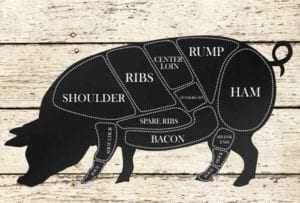
It’s almost always a good idea to brine pork. Brining makes it flavorful and keeps it juicy. This particular recipe is distinguished by its use of garlic and rosemary, but you can flavor it with almost anything. The amount of brine below is ideal for up to 4 pounds of pork.–Thomas Keller
LC Just Do As The Man Says Note
It may seem sorta silly to heat the brine for just a minute, as the recipe below stipulates, but chef Thomas Keller knows what he’s doing. Not only does the heat facilitate the dissolving of the salt and honey, it draws out the essential oils of the herbs, which, in turn, equates to flavor. Lots of flavor. And not flavor in an overwhelming way. Just in a nicely complementary way. You know how back in the day when gentlemen would walk down the street and, when they encountered an acquaintance, they’d offer one another a slight head bow and lift of the hat as they said “Good day”? That’s how nicely and politely the flavors play with one another. Anyways, we diverge. Just do as the man says.

Pork Brine
Ingredients
- 1/4 cup plus 2 tablespoons honey
- 12 bay leaves
- 3 large rosemary sprigs
- 1/2 bunch thyme
- 1/2 bunch flat-leaf parsley
- 1/2 cup garlic cloves, crushed, skin left on
- 2 tablespoons black peppercorns
- 1 cup kosher salt, preferably Diamond Crystal
- 8 cups water
Instructions
- Combine all of the ingredients in a large pot, cover, and bring to a boil. Heat for 1 minute, stirring to dissolve the salt.
- Remove from the heat and cool completely. Chill before using.
Notes

Explore More with AI
Nutrition
Nutrition information is automatically calculated, so should only be used as an approximation.
Recipe Testers’ Reviews
I regularly brine pork and enjoy experimenting with different brine flavors. As the salt content of this was a touch high, I brined two pork tenderloins for six hours and discovered upon cooking that any longer would have been too long. At that point, they were perfectly seasoned, but from experience, I know how brines act. Most brines I make contain white or brown sugar or maple syrup, but this one contains honey as well as a lot of garlic, fresh herbs (including rosemary) and peppercorns. I served the pork with an apricot glaze that married nicely with the brine (tasting the pork both with the glaze and without). The brine announced itself loud and clear. It would be tasty with chicken parts, too.










I’ve been using this recipe for years to brine the chicken I use for beer-can chicken. I even put some of the leftover brine in the can that goes inside the chicken! It is simply amazing!
I also cut the salt in half, but since I always make a double recipe (one chicken just isn’t enough for the crowd I usually feed), I end up using the full cup of salt (I use Windsor Kosher–I’m in Canada) but for 16 cups of water.
Carl, thanks for the chicken brining suggestions. I make beer can chicken all the time and this will be on my list when I make it next. Cheers!
I use a similar brine for chicken and turkey. Try adding about 6 chopped jalepenos and the rind and juice of a whole lime and half a cup of brown sugar.
Steve, excellent suggestion, thanks.
I just weighed out the the salt and 5 ounces of Mortons Kosher is ~ 1/2 cup.
Hi there WSJevons, yes, you are correct. Mortons Kosher salt will weigh differently than the Diamond Crystal specified in the recipe. There is a great article http://dinersjournal.blogs.nytimes.com/2010/04/28/warning-measure-your-salt/ if you want to read more about the differences in the production and resultant crystals of these salts.
It should be 1 cup of salt to 1 gallon or 16 cups of water.
Hey Chef d, we checked and doubled checked then checked in with Keller’s people, and it is indeed 1 cup of salt to 8 cups of water. But the recipe is used for his Pork Belly Confit, which is brined for only 10 hours.